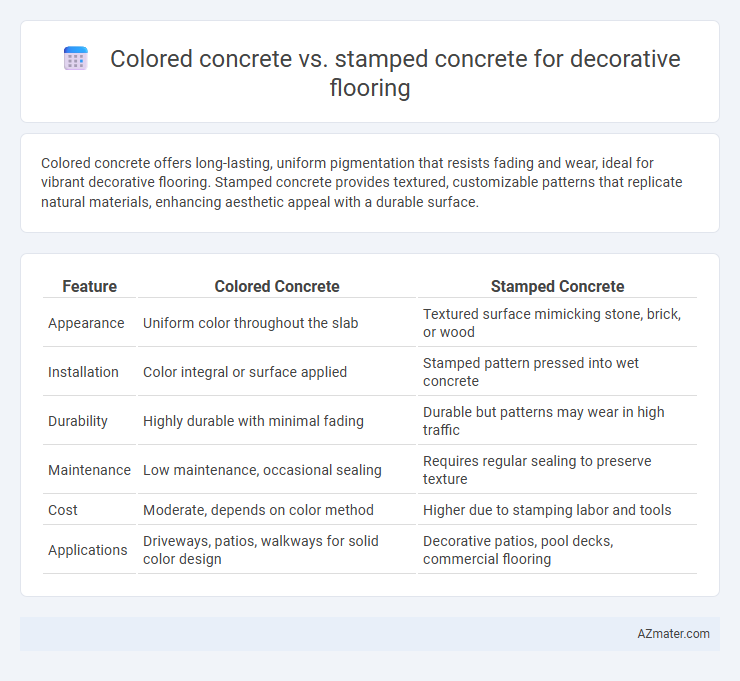Colored concrete offers long-lasting, uniform pigmentation that resists fading and wear, ideal for vibrant decorative flooring. Stamped concrete provides textured, customizable patterns that replicate natural materials, enhancing aesthetic appeal with a durable surface.
Table of Comparison
| Feature | Colored Concrete | Stamped Concrete |
|---|---|---|
| Appearance | Uniform color throughout the slab | Textured surface mimicking stone, brick, or wood |
| Installation | Color integral or surface applied | Stamped pattern pressed into wet concrete |
| Durability | Highly durable with minimal fading | Durable but patterns may wear in high traffic |
| Maintenance | Low maintenance, occasional sealing | Requires regular sealing to preserve texture |
| Cost | Moderate, depends on color method | Higher due to stamping labor and tools |
| Applications | Driveways, patios, walkways for solid color design | Decorative patios, pool decks, commercial flooring |
Introduction to Decorative Flooring Solutions
Colored concrete offers vibrant, long-lasting hues by integrating pigments directly into the mix, ensuring uniform color distribution ideal for decorative flooring. Stamped concrete enhances aesthetics by imprinting patterns and textures that mimic natural materials like stone or brick, providing a tactile and visually rich surface. Both solutions deliver durable, customizable options that elevate interior and exterior spaces with artistic appeal and structural integrity.
What is Colored Concrete?
Colored concrete involves integrating pigments directly into the concrete mix, creating a uniform, vibrant hue throughout the material, ideal for long-lasting decorative flooring. This method ensures color consistency even as the surface wears or ages, distinguishing it from surface treatments like staining or painting. Colored concrete offers versatility in design and durability, making it a popular choice for patios, walkways, and interior floors seeking both aesthetic appeal and structural integrity.
What is Stamped Concrete?
Stamped concrete is a decorative flooring technique that involves imprinting patterns and textures onto freshly poured concrete to mimic the appearance of materials such as brick, stone, or wood. This method enhances surface aesthetics while maintaining the durability and low maintenance benefits of concrete. Compared to colored concrete, stamped concrete offers a more intricate and textured finish, providing greater design versatility for flooring applications.
Design Versatility: Colored vs Stamped Concrete
Colored concrete offers a broad palette of hues achieved through integral pigments, enabling uniform color throughout the slab and greater design flexibility for solid or blended tones. Stamped concrete provides intricate textures and patterns that replicate natural materials such as stone, brick, or wood, adding dimensionality and authentic visual appeal. Combining colored concrete with stamping techniques enhances aesthetic options by blending vibrant colors with detailed surface patterns for highly customized decorative flooring solutions.
Installation Process and Techniques
Colored concrete involves integrating pigments directly into the concrete mix for uniform color throughout the slab, requiring precise mixing and consistent batching to ensure color consistency. Stamped concrete utilizes molds pressed into freshly poured concrete to create textured patterns, demanding skilled timing to achieve the right concrete hardness for clear imprinting and subsequent detailed coloring techniques. Both methods rely on proper curing processes, but stamped concrete often includes additional steps like releasing agents and sealing to enhance texture and durability.
Durability and Longevity Comparison
Colored concrete offers exceptional durability with embedded pigments that resist fading and wear, maintaining vibrant hues for decades. Stamped concrete provides a textured, decorative surface that mimics natural materials but may require periodic resealing and repairs to preserve its appearance and prevent cracking. Both options deliver strong longevity, yet colored concrete generally outperforms stamped concrete in sustained resistance to weathering, abrasion, and UV exposure.
Maintenance Requirements: Colored vs Stamped Concrete
Colored concrete requires minimal maintenance, with occasional cleaning and resealing every 3-5 years to preserve its hue and prevent surface wear. Stamped concrete demands more frequent upkeep, including periodic resealing every 2-3 years to maintain color vibrancy and protect against cracking or fading due to texture depth. Both materials benefit from prompt stain removal and routine cleaning to enhance longevity and aesthetic appeal in decorative flooring applications.
Cost Analysis and Budget Considerations
Colored concrete offers a cost-effective solution for decorative flooring, typically priced between $3 to $10 per square foot, making it ideal for budget-conscious projects seeking vibrant, uniform hues. Stamped concrete, ranging from $8 to $18 per square foot, incurs higher costs due to intricate patterns and texture molds, aligning better with upscale designs requiring detailed aesthetics. Budget considerations must account for installation complexity, maintenance expenses, and potential color fading, with colored concrete demanding less upkeep and stamping requiring periodic sealing to preserve visual impact.
Aesthetic Appeal and Customization Options
Colored concrete offers a vibrant, uniform coloration ideal for modern, minimalist designs, allowing precise pigment integration for seamless, long-lasting hues. Stamped concrete provides rich texture and patterns mimicking natural materials like stone, brick, or wood, delivering highly customizable, intricate surface designs suitable for creating unique decorative flooring styles. Both techniques enhance aesthetic appeal, with colored concrete excelling in consistent color saturation and stamped concrete offering dynamic, tactile customization options.
Choosing the Right Decorative Concrete for Your Space
Colored concrete offers precise, uniform hues ideal for achieving consistent, vibrant flooring that complements modern and minimalist designs. Stamped concrete provides textured patterns and natural stone or tile imitations, perfect for creating visually dynamic surfaces with depth and character. Selecting the right decorative concrete depends on your space's design goals, maintenance preferences, and desired aesthetic impact.

Infographic: Colored concrete vs Stamped concrete for Decorative flooring
 azmater.com
azmater.com